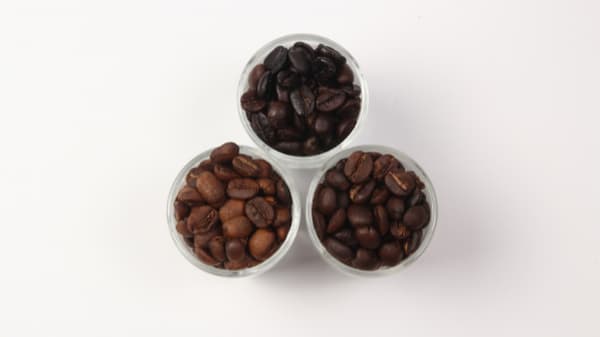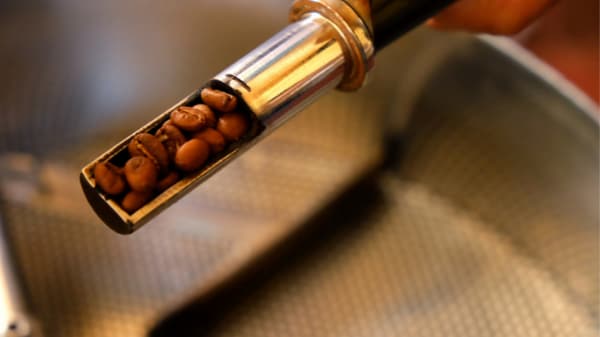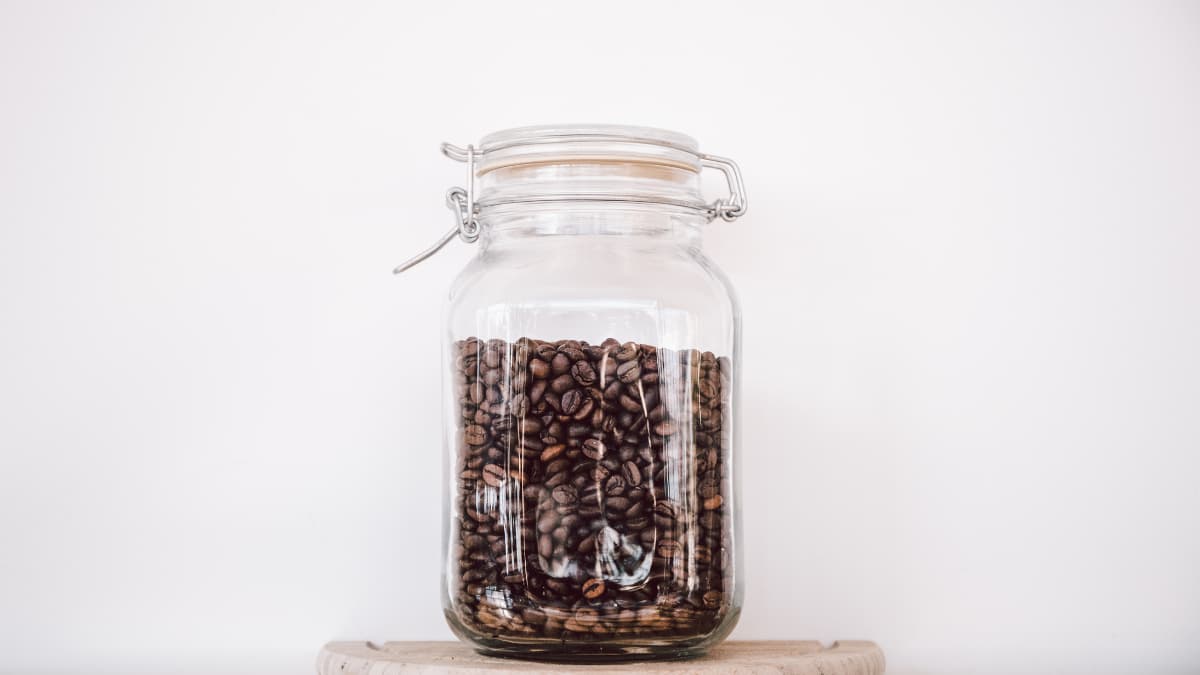Light Roast VS Dark Roast Comparison
Let’s imagine you’re at a coffee shop bar. The barista asks you if you would like your coffee brewed with a dark roast or a light roast. How do you answer?
Maybe you wouldn’t know the best answer to that question. After all, do coffee roast levels really change how you enjoy your coffee?
Yes, roasting coffee can completely change a coffee bean, for better or for worse.
In this article, I’ll go over what light roast and dark roast coffee beans are to help you decide which one you should be drinking.

The 3 Types: Light, Medium And Dark Roast
The 3 basic kinds of coffee roasts are light, medium, and dark.
What is Light Roast Coffee?
Light roast coffee is coffee that is roasted for a shorter time or at a lower temperature.
Light roasted coffee has a light brown color and higher acidity with a slightly lower body. Coffee is considered to be a lighter roast about 9-12 minutes into the roasting process.
But that time will vary depending on the amount of coffee being roasted, the type and size of roaster, and temperature variations.
As I already mentioned, roast levels can change everything about coffee beans. Green coffee beans (AKA unroasted coffee) don’t have pleasant aromas or flavor.
Roasting changes that. How the coffee is roasted will alter the flavor, color, body, acidity, aromas, and tastes. In other words, the roast level has the power to completely transform a coffee bean.
What happens during coffee roasting?
During coffee roasting the roaster essentially heats coffee beans until their sugars begin to develop. The beans take on a darker color, and their chemical composition changes.
As the bean’s internal temperature increases, the bean structure breaks down.
The coffee beans begin to make a cracking, or popping, sound that you can actually hear. That usually happens at around 390 degrees Fahrenheit, and it’s called first crack.
That’s when the beans are considered roasted, and you can brew those beans and get a delicious cup of coffee.
At this point, the beans are a light brown color. The acidity level in lighter roast coffee is still high. And you can still perceive the characteristics of origin.
Coffees from different countries can taste different, even radically different, than coffees from other regions. When you roast a coffee light, you can still detect those regional differences.
There are many names for lighter roast coffees. Since each coffee company selects a name for their roast, you’ll find that there is little standardization of terms.
When choosing a coffee from a company you’ve never bought from, take a close look at any pictures they offer of the roasted beans.
You’ll be able to identify lighter roasts to a certain extent just by looking at the color.
Light coffee roast is sometimes called:
- Cinnamon roast
- Half City Roast
- Light City Roast
- New England Roast
There are also many variations of coffee roast levels within the term light roast. Some light roasts can be very close to a medium roast. Medium roasts are at times called American Roast, Breakfast Roast, or sometimes City Roast.
What Is Dark Roast Coffee?
Dark roast coffee is coffee that has been roasted for a longer time or at higher temperatures. Dark roast beans have a dark brown color and an oily surface.
The roasting temperature reaches 464 degrees Fahrenheit or slightly higher. The beans are typically roasted anywhere from 14-18 minutes, or perhaps a bit longer.
At around 440 to 455 degrees Fahrenheit, carbon dioxide has built up inside the beans to the point that they actually expand and they crack again.
This second crack marks the moment when beans are considered dark.
Dark roasts tend to be less dense because they’ve lost moisture, which means they weigh less per volume.
The complexity of the flavors of the bean’s origin is lost, and what remains is the taste of roast. We’ll talk about that a bit more in a minute.
Since there is no standardization for roast levels in the coffee industry, each roaster decides on their own roast level and what they want to call their beans. Dark color coffee beans are sometimes called:
- Vienna roast
- Espresso roast
- Continental roast
- French roast
- Italian roast
Related Read: Medium VS Dark Roast

Light VS Dark Roast Coffee Compared
What is the difference between light and dark roast coffees?
The basic variations between the two come down to how the roast has affected the caffeine content, flavor, aromas, and color.
Caffeine Content
There are a lot of opinions flying around about the amount of caffeine in lighter roasts when compared to dark roast beans. Many people feel that the deep rich flavors of dark roast coffee indicate that there is more caffeine.
The simple reality is there’s not that much of a difference. Light roast coffees and dark roast coffees have roughly the same amount of caffeine.
But if you want to get into the nitty-gritty of caffeine levels, dark roasts actually have a bit less caffeine.
Since caffeine gets burned off during the roasting process, coffee beans that were roasted longer have less caffeine.
This is offset, though, by the weight of the bean. If you weigh your beans before brewing (please do!), then this isn’t a factor.
But if you’re using scoops to measure out your coffee dose, the density of the bean is going to play with the end results – and with the amount of caffeine – of your drink.
Dark beans lose moisture during roasting, are less dense, and weigh less than light beans. So 1 ounce of dark roasted beans has a lot more beans (more volume) than 1 ounce of lighter roast beans.
If you’re using a scoop to measure out your dark beans, you’re actually brewing with less coffee.
Less coffee means less caffeine in the brew. But in general, lighter roast coffees contain a bit more caffeine per volume.
Related Read: Coffee Roast Caffeine Content
Flavor
Lightly roasted
If you’re looking for a coffee that gives you exciting and complex flavors, lighter roasts will be your favorite. You’ll find all the flavors of origin in a lighter roast, along with notable acidity.
A broader set of flavor notes are found in lighter coffees, such as orange blossoms, lemongrass, or blueberries.
These fruity tastes can seem unbalanced to new drinkers, but to experts they’re thrilling. Flavor is a major difference between a light and dark roast.
Darker roasted
If you turn to coffee for a comforting drink that has dependable tastes, you might fancy both a medium and dark roast.
You’ll find a more balanced flavor that tends to dark chocolate or deep caramel sweetness. At this point, beans taste like the roast process rather than origin. So expect flavors of chocolate, toast, and some smoky notes.
The body is heavier because the oils inside the coffee beans have seeped out and coated the beans. And you’ll definitely get a heightened taste of bitterness.
Aroma and Look
Light roast
Light roast coffee beans are a lighter brown color. The bean looks dry, with no oil.
When you smell light roasts, you’ll notice the bright, fruity aroma. You might note the aromas of origin, such as blueberry, raspberry, orange, or herbal notes like lemongrass.
Dark roast
As you would imagine, dark roasts have a luxuriant dark color. The surface is often shiny since the oils inside the beans come out towards the end of the roasting process.
This oily covering gives the beans an appealing polished look. When you smell them, you’ll get the aromas of roast: chocolate, toast, and in some cases a smoky smell.

Brewing Method
Not all brewing methods get the best out of each type of roasted coffees. This section will explain why and what steps you can take to get the best results.
Lighter roast
There’s a common belief that light roasts can’t be used for espresso. No. That’s incorrect. You can use light roast beans for espresso.
But why are they often avoided?
Darker roasts are more soluble because the bean’s structure has broken down more. So in the short extraction time when making an espresso, it’s easier to properly extract the coffee grounds with a darker roast.
Lighter roasts can create an under-extracted espresso, which will taste sour and not at all pleasant.
But you can brew espresso with a lighter roast and enjoy the complex flavors. Grind your beans finer and try brewing with slightly higher temperatures when using light roasts.
If you use a V60 pour-over to brew a lighter roast coffee, you’ll take advantage of all the sweetness in the bean.
Consider letting the coffee brew slightly longer with light roasts to fully extract the complex flavors.
You can use a Chemex to brew light roasts and see how it enhances all the subtle notes in the beans, such as the delicate, floral, and herbal aromas and tastes.
Aeropress will bring out the tart notes in your light roasts. And if you love cold brew, you’ll love it with lighter roasts since it lowers the acidity but keeps the complexity.
Darker roast
Darker roast beans are loved for their strong flavors and rich body. If you want to accentuate those attributes and love manual brewing methods, use a French Press.
Remember that a dark roast coffee, like a French Roast, will extract a bit faster than lighter roasts.
Darker roasts and espressos go hand in hand. The espresso process will accentuate the acidity, but since dark roasts have little acidity, that’s just fine.
It’s easier to pull espresso shots with a dark roast since the extraction time is less fussy. Keep a close eye on the brew temperature since dark roasts often brew better at a lower temperature.
And if you’re a lover of pour-overs, you might want to save them for your lighter roasts.
Pour-over methods aren’t great with dark roasts because there are less complex flavors to extract.
Which Is Right For Me?
As a coffee drinker, you might find you love one type of roast over another. You might flat out refuse a darker roast, or you may decide to avoid lighter roasts like the plague.
But you might find that the battle lines are not so easy to draw. You may find uses for both light and dark roast coffee.
You may prefer a dark roast for espressos, while you enjoy the complex flavors of a lighter roast for pour-overs.
You may like a certain roast according to the time of day. For instance, you might reach for a bright and refreshing light roasted coffee for that early morning cup, while you like a comforting dark roast after dinner.
Or you can take the middle of the road and prefer a medium roast coffee. Popular medium roast coffees can balance out the positive aspects of both a lighter roast and a dark roast.
Medium roasts can have a more balanced acidity and a pleasant sweetness while still retaining the flavors of origin. Whatever your preferences, know that there’s the perfect roast for you.

